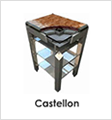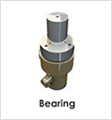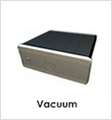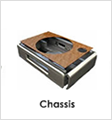


Castellon Stand |
Castellon
World Class Stand Design
Completing the Caliburn-Cobra analogue playback system, the Castellon was built to defend the Caliburn from external vibrations.
Continuum Audio Labs developed a scientifically designed "floating platform" which uses a combination of magnetic and pneumatic isolation technologies.
Two heavy opposing magnetic plates isolate the Caliburn from external vibrations with no hard flanking paths.
During the research and development phase Continuum Audio Labs invested a considerable sum in purchasing a number of well proven isolation technologies.
These included active and passive systems from some of the leading manufacturers of isolation technologies used for atomic force microscopes and other sensitive applications.
There are many definitions of the term "active", and these include piezo and voice-coil computer-controlled cancellation devices, pendulum based systems, vibration modifiers such as elliptical cup and ball systems, oil and fluid damped spring systems, c-shaped elliptical spring systems and self-levelling pneumatic systems.
Suffice to say, one could fill several hundred pages describing various methods of tackling the problem of isolating an actively vibrating object (ie. a turntable) from external vibration, whilst coping with self-generated vibrations caused by the spinning mass of platter and motor combination.
Isolation
The basic formula used to describe an isolation system is Omega (W) = Sq root of K over M where W is the resonant frequency and K is the stiffness of the spring system and M is the mass of the object being isolated.
Damping is an additional consideration into this mix and is a critical part of developing a working solution.
Undamped springs are in our opinion a non-ideal isolation solution.
Damping is required. Imagine driving a car with a spring suspension and no shock absorbers. It is quickly apparent that a damping mechanism such as a shock absorber is critical to reducing the amount of cycles of the suspension system experiences when exposed to external stimuli.
So the properties of the damping mechanism are important as are parasitic effects of combinations of materials. These must be taken into account when designing a solution. Parasitic effects are caused by things such as bellows, fluid seals and other necessary engineering details to move from the purely theoretical to the real world.
Listening Tests
In listening tests we confirmed correlations between the predicted isolation and the sonic results. This led us to question the prior art and forge new approaches to tackling the unique issues associated with turntable isolation.
For example if the motor and platter are connected by a belt and the motor is sitting on separate plane to the suspended chassis and platter then the suspension of the platter and chassis would be constantly excited by the reaction to bearing friction and Young's Modulus constraints of the suspension system.
The Castellon was designed to isolate the Caliburn Motor and Chassis from external sources of vibration but keep the MOTOR and CHASSIS on the same plane. This stops bobbing, twisting, yawing, pitching and flexural modes visible under the Finite Element Method and audible to experienced audiophiles.
The Design
The Castellon was designed using the finite element method for both the mechanical and magnetic spring damper elements.
The Castellon is designed as a complete system when used with the Caliburn. Whilst other isolation solutions are completely valid, in our experience none offered the sonic advancements achieved by the Castellon-Caliburn combination.
There is a significant amount of sophisticated engineering in this stand. For an isolation system to work, the ideal support structure must be infinitely stiff, otherwise the movement of the stand will interfere with the isolation system.
To achieve the best possible result the Castellon uses a nautical turnbuckle system which exerts a significant amount of force to cross-brace the vertical legs and resist rocking motions.
Additionally, the rear of the stand is braced to resist sideways movement. Each shelf is structurally braced to resist torsional and buckling modes.
This results in a structurally rigid platform which raises the eigen modes into a zone where purpose-made elastomers are used in a constrained layer to damp the remaining vibrations.
Finally, the top shelf is an over-damped magnetic spring where the magnetic field is constrained close to a point of collapse, resulting in a very low resonant frequency ideally focussed to work in harmony with the Caliburn.
The system is passive and does not require complex air compression and filtering solutions.
The system can not be driven into over-compensation where the source of vibration exceedes the fine tolerances of a sensor which can then cause an active solution to get confused with the source vibration and its own self-generated counter-vibration.
This state is not ideal, but has been observed in some commercial isolation solutions.
The Castellon is precision-machined in aircraft-grade aluminum.
|










